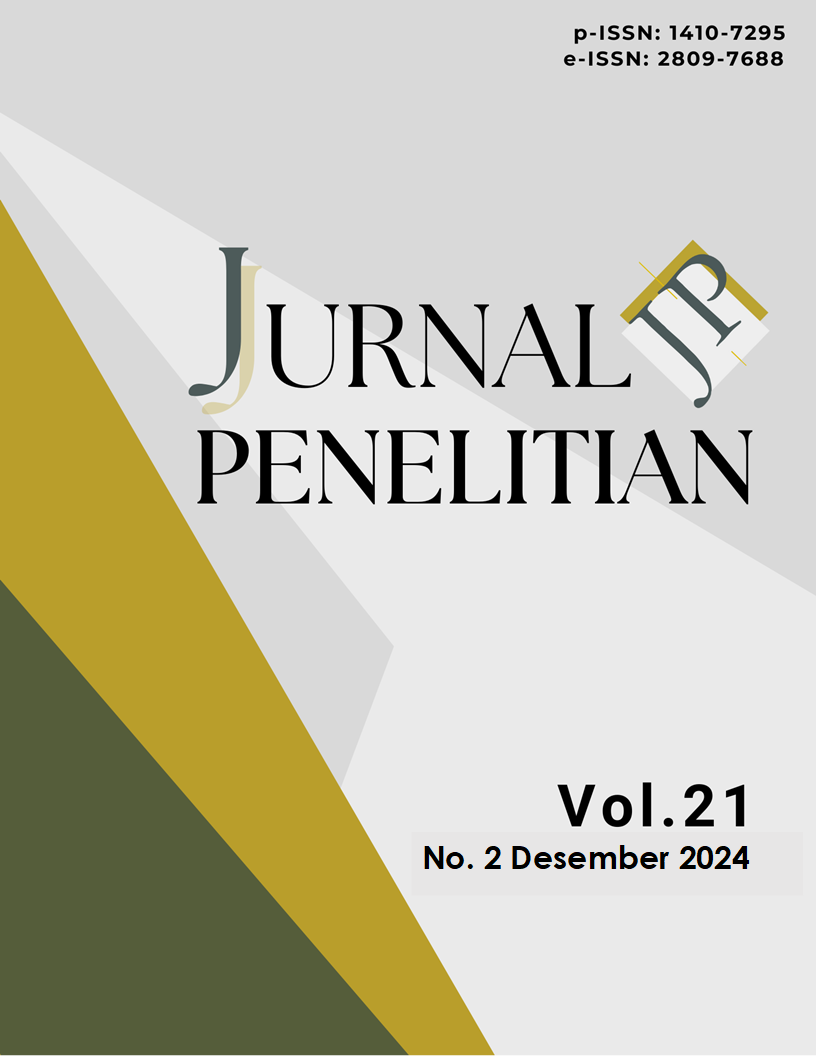The Role of Entrepreneurial Marketing in Achieving Competitive Advantage in Micro, Small and Medium Enterprises (MSMEs)
DOI:
https://doi.org/10.26905/jp.v21i2.15695Keywords:
Competitive Advantage, Entrepreneurial Marketing, Environmental DynamicsAbstract
The micro, small and medium enterprises (MSMEs) sector continues to drive the national economy as a crucial and strategic sector. Competitive ability is a key factor for companies to succeed and survive in the existing situations and conditions, especially in facing unexpected and rapid business environment changes (environmental dynamics). This research aims to examine how environmental dynamics affect competitive advantage, both directly and through the role of entrepreneurial marketing strategies, among business actors in the Tempe Chips Industry Centre in Sanan, Malang City, as an evaluation for future business development to build competitive advantage in running their business. Explanatory research employs a quantitative methodology, collecting data through questionnaires and analysing it using SmartPLS. The results show that environmental dynamics do not directly affect competitive advantage, but have been proven to influence entrepreneurial marketing strategies, which in turn significantly enhance competitive advantage. This means that the role of entrepreneurial marketing is as a bridge between environmental dynamics and the enhancement of competitive advantage; thus, entrepreneurial marketing becomes an important mediating variable. Thus, in the midst of a dynamic business environment, entrepreneurs need to be more innovative and adaptive to remain competitive.
Downloads
References
Becherer, R. C., Howard Finch, J., & Helms, M. M. (2005). The Influences of Entrepreneurial Motivation and New Business Acquisition on Strategic Decision Making. Journal of Small Business Strategy.
BPS Provinsi Jawa Timur. (2024). Ekonomi Jawa Timur Tahun 2023. https://jatim.bps.go.id/id/pressrelease/2024/02/05/1456
Carson, D., & Gilmore, A. (2000). SME marketing management competencies. International Business Review. https://doi.org/10.1016/s0969-5931(00)00006-8
Darwanto, D. (2013). Peningkatan Daya Saing UMKM Berbasis Inovasi dan Kreativitas (Strategi Penguatan Property Right terhadap Inovasi dan Kreativitas). Jurnal Bisnis Dan Ekonomi, 20(2).
DeNisi, A. S., Hitt, M. A., & Jackson, S. E. (2003). The knowledge-based approach to sustainable competitive advantage. Managing Knowledge for Sustained Competitive Advantage: Designing Strategies for Effective Human Resource Management.
Dess, G. G., & Beard, D. W. (1984). Dimensions of Organizational Task Environments. Administrative Science Quarterly. https://doi.org/10.2307/2393080
Ferdinand, A. (2014). Metode penelitian manajemen: Pedoman penelitian untuk penulisan skripsi tesis dan desrtasi ilmu manajemen.
Ghozali, I., & Latan, H. (2015). Konsep, teknik, aplikasi menggunakan Smart PLS 3.0 untuk penelitian empiris. BP Undip. Semarang, 290.
Hair, J. F., Black, W. C., Babin, B. J., & Anderson, R. E. (2010). Multivariate Data Analysis. In Vectors. https://doi.org/10.1016/j.ijpharm.2011.02.019
Justin Tan, J., & Litsschert, R. J. (1994). Environment‐strategy relationship and its performance implications: An empirical study of the chinese electronics industry. Strategic Management Journal. https://doi.org/10.1002/smj.4250150102
KADIN Indonesia. (2024). UMKM Indonesia. Kamar Dagang Dan Industri (KADIN) Indonesia. https://kadin.id/data-dan-statistik/umkm-indonesia/
Khouroh, U., Sudiro, A., Rahayu, M., & Indrawati, N. K. (2020). The mediating effect of entrepreneurial marketing in the relationship between environmental turbulence and dynamic capability with sustainable competitive advantage: An empirical study in Indonesian MSMEs. Management Science Letters. https://doi.org/10.5267/j.msl.2019.9.007
Kraus, S., Harms, R., and Fink, M. (2009). Entrepreneurial Marketing: Moving beyond Marketing in New Ventures. Int. J. Entrepreneurship and Innovation Management, 11(1), 19–34.
Miles, M. P., & Arnold, D. R. (1991). The Relationship between Marketing Orientation and Entrepreneurial Orientation. Entrepreneurship Theory and Practice. https://doi.org/10.1177/104225879101500407
Miles, M. P., & Darroch, J. (2006). Large firms, entrepreneurial marketing processes, and the cycle of competitive advantage. European Journal of Marketing. https://doi.org/10.1108/03090560610657804
Morris, M. H., Schindehutte, M., & LaForge, R. W. (2002). Entrepreneurial Marketing: A Construct for Integrating Emerging Entrepreneurship and Marketing Perspectives. Journal of Marketing Theory and Practice. https://doi.org/10.1080/10696679.2002.11501922
Power, B., & Reid, G. C. (2005). Flexibility, firm-specific turbulence and the performance of the long-lived small firm. Review of Industrial Organization. https://doi.org/10.1007/s11151-005-0224-5
Sarfiah, S. N., Atmaja, H. E., & Verawati, D. M. (2019). Umkm Sebagai Pilar Membangun Ekonomi Bangsa Msmes the Pillar for Economy. Jurnal REP (Riset Ekonomi Pembangunan).
Suardhika, I. N., Salim, U., Troena, E. A., & Thoyib, A. (2012). Integrasi Sumber Daya Strategis, Orientasi Kewirausahaan dan Dinamika Lingkungan sebagai Basis Strategi Bersaing serta Pengaruhnya terhadap Kinerja Usaha (Studi pada Usaha Kecil & Menengah di Bali). Jurnal Aplikasi Manajemen, 10(1), 216–227.
Syahbudi, M., & Ma, S. E. I. (2021). Ekonomi Kreatif Indonesia: Strategi Daya Saing UMKM Industri Kreatif Menuju Go Global (Sebuah Riset Dengan Model Pentahelix). Merdeka Kreasi Group.
Van Egeren, M., & O’Connor, S. (1998). Drivers of market orientation and performance in service firms. Journal of Services Marketing. https://doi.org/10.1108/08876049810202357
Vinsensia, D., Utami, Y., Jannah, N., & Wulandari, D. I. (2023). Penerapan Inovasi Desain Kemasan Sebagai Branding Produk Usaha Mikro Kecil Menengah (UMKM). Jurnal Pengabdian Kepada Masyarakat Nusantara, 4(3), 2306–2311.
Ward, P., and Duray, R. (2000). Manufacturing strategy in contrext: environment, competitive strategy and manufacturing strategy. Journal of Operations Management, 18, 123–138.
Waris, A., Setiyorini, W., & Chodidjah, C. (2020). Marketing Intelligence dalam Menumbuhkan Jiwa Entrepreneur pada Generasi Milenial. JURNAL MANAJEMEN DAN KEWIRAUSAHAAN, 8(1). https://doi.org/10.26905/jmdk.v8i1.4245
Wold, S., Kettaneh, N., & Tjessem, K. (1996). Hierarchical multiblock PLS and PC models for easier model interpretation and as an alternative to variable selection. Journal of Chemometrics. https://doi.org/10.1002/(sici)1099-128x(199609)10:5/6<463::aid-cem445>3.0.co;2-l
Downloads
Published
How to Cite
Issue
Section
License
Copyright (c) 2025 Jurnal Penelitian

This work is licensed under a Creative Commons Attribution-ShareAlike 4.0 International License.
Authors who publish in this journal agree to the following terms:
- Copyright of the published articles will be transferred to the journal as the publisher of the manuscripts. Therefore, the author confirms that the journal has managed the copyright.
- Publisher of Abdimas: Jurnal Pengabdian Masyarakat Universitas Merdeka Malang is University of Merdeka Malang.
- The copyright follows the Creative Commons Attribution-ShareAlike License (CC BY SA): This license allows to share, copy, and redistribute the material in any medium or format, adapt, remix, transform, and build upon the material, for any purpose, even commercially.


